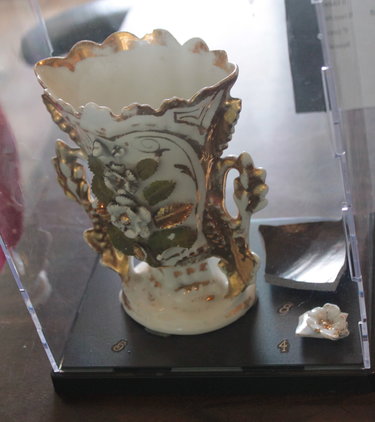‘Devastating’: Underground Railroad Center program derailed by IMLS cuts
Enterprise file photo — Melissa Hale-Spencer
A gilded lone blossom, at lower right, unearthed in an archeological dig on Livingston Avenue in Arbor Hill led to this display at the Underground Railroad Education Center with a similar 19th-Century French vase. Mary Liz Stewart said items like the vase are significant because there is a common misconception that African Americans before the Civil War were either slaves or very poor. The center’s home in the brick rowhouse at 174 Livingston Ave. was once the home of abolitionists Stephen and Harriet Myers.
ALBANY — Cuts in federal funds have delayed or perhaps derailed a program at the Underground Railroad Education Center set to launch in October with the goal of democratizing the museum field.
The center was notified this week that its $33,454 grant has been terminated without cause by the Institute of Museum and Library Services.
The grant was to be matched by the education center, which is working with the Rochester Institute of Technology, and with local historic sites and repositories.
Mary Liz Stewart, who founded the Underground Railroad center with her husband, Paul, in the 1990s, said the idea for the museum project came when she was looking for quotes by Black Americans for a newsletter the center regularly puts out.
She came across this one by Shirley Chisolm, the first Black woman elected to Congress: “If they don’t give you a seat at the table, bring in a folding chair.”
Stewart said she realized “museum stories now are very one-sided.” She went on, “We need to take a proactive step to change that.”
With the grant money, Lacey Wilson was set to manage the Museum Studies Teen Program Project.
“We want to keep Lacey,” said Stewart. “She’s done a lot of work and planning. She is just now finalizing the program.”
The grant was intended to fund a program that would give high school students hands-on learning experience in the museum field during their junior and senior years and during the summer in between. It would prepare them for a career in a museum field or for enrollment in an undergraduate museum-studies program.
The students were to conduct research, create tours, and design exhibits and educational programming for Capital Region residents.
They would take a “deep dive” into the world of museums, Stewart said, and find out what “makes the museum world tick.” This would involve working with local collections, not just on exhibits but on everything from archival research to administration.
Stewart gave an example of one planned project in which students would identify statues in Albany, describing them and categorizing whose stories they tell — or don’t tell.
Partnerships would be arranged “where the kids would do real museum work,” Stewart said, based on their interest in art, or history, or science.
Wilson was planning to visit local schools and churches in May to recruit students for the program.
“The loss of this grant is devastating,” said Wilson in a release from the center. “As a result, it is doubtful that the program will be able to be launched in October 2025 as planned.”
IMLS
President Donald Trump’s March 14 executive order, “Continuing the Reduction of the Federal Bureaucracy,” named the Institute of Museum and Library Services among seven agencies he determined were “unnecessary.”
The IMLS serves 35,000 museums and 123,000 libraries across the country, its website says; in 2024, it issued 633 grants to museums, libraries, and states totaling $270 million, distributing the congressionally approved funds across all 50 states and Washington, D.C.
Mary Liz Stewart described opening an email on Wednesday, April 16, that had been sent at 9:55 the night before.
“Lo and behold, there was this announcement,” she said, as she read the terse message to The Enterprise: Dear IMLS grantee … Please see the attached notice …. Best wishes.”
“There was no organization name, no contact name, no identification number for the grant,” said Stewart.
The attachment said, “Your award was terminated on April 8.”
The Stewarts are not alone in suffering an abrupt and unexplained end to their grant.
At an April 16 roundtable at the Bethlehem Public Library on IMLS cuts hosted by Congressman Paul Tonko, librarians as well as Tonko spoke not just of the harm caused by the cuts but also, like Stewart, of the lack of information about the cuts or about the institute itself.
“There’s no information coming out of the Institute for Museum and Library Services,” said State Librarian Lauren Moore, noting the frustration. “There are a lot of questions and we have not received any answers,” she said.
When IMLS was “fully functional,” Stewart said, the institute had been “a real delight” to work with.
IMLS worked on a reimbursement basis, Stewart explained, and she would regularly submit digital paperwork for expenses and be reimbursed for half within three days. She described the process as “smooth and easy.”
Now, however, although it appears thousands of similar grants have been canceled without explanation, there is no official public list of those grants.
One of the initial reviewers for the Underground Railroad grant program had commented, “I believe this project is poised for successful implementation.”
Stewart is frustrated to have the critical funding cut, without review or explanation, and with no information on how to move forward. Getting answers from IMLS has been virtually impossible.
She is still excited about working with the Rochester Institute of Technology on the project, particularly with Julee Decker, a history professor, who is the director of the museum-studies undergraduate degree program.
But RIT cannot help make up the lost funding, Stewart said, as the university has suffered federal cuts of its own.
Stewart said the Underground Railroad Education Center will continue to look for funds to support the program as best it can. “Our buckets are not terribly full,” said Stewart.
People who want to donate may do so through the center’s webpage — undergroundrailroadhistory.org — which also gives an address for mailed donations.
Stewart has also applied to the state’s Office of Cannabis Management for a grant because it has as a priority workforce development.
Labor of love
For decades, the Underground Railroad History Project, as it was originally called, has been a labor of love for the Stewarts. In the 1990s, they purchased a brick row house at 194 Livingston Ave. that was the home of Black abolitionists Stephen and Harriet Myers.
Stephen Myers was the editor of The Northern Star and Freeman’s Advocate. “We devote all our time to the care of the oppressed who come among us,” he wrote in 1860.
Largely through grants and volunteer efforts, the Stewarts’ organization saved the venerable brick row house that had been on the verge of collapse. It serves as both a museum and a space for meetings and myriad events. Plans are underway for an interpretive center to be built next to the Myers house.
The center researches and preserves the local and national history of the Underground Railroad movement, its international connections, and its legacy to today’s social justice issues, with the goal of empowering people of all ages to be agents of change toward an equitable and just society.
Mary Liz Stewart told The Enterprise this week, “Some days, I turn to Paul and say, ‘It feels like the Federal Fugitive Slave Law and bounty hunters again.’”
But, Stewart went on, she is encouraged by the expanding number of people coming out to protest.
“I tell myself the Phoenix will rise,” she said.


